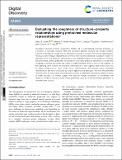Evaluating the roughness of structure–property relationships using pretrained molecular representations
Author(s)
Graff, David E; Pyzer-Knapp, Edward O; Jordan, Kirk E; Shakhnovich, Eugene I; Coley, Connor W
DownloadPublished version (1.082Mb)
Publisher with Creative Commons License
Publisher with Creative Commons License
Creative Commons Attribution
Terms of use
Metadata
Show full item recordAbstract
Quantitative structure–property relationships (QSPRs) aid in understanding molecular properties as a function of molecular structure. When the correlation between structure and property weakens, a dataset is described as “rough,” but this characteristic is partly a function of the chosen representation. Among possible molecular representations are those from recently-developed “foundation models” for chemistry which learn molecular representation from unlabeled samples via self-supervision. However, the performance of these pretrained representations on property prediction benchmarks is mixed when compared to baseline approaches. We sought to understand these trends in terms of the roughness of the underlying QSPR surfaces. We introduce a reformulation of the roughness index (ROGI), ROGI-XD, to enable comparison of ROGI values across representations and evaluate various pretrained representations and those constructed by simple fingerprints and descriptors. We show that pretrained representations do not produce smoother QSPR surfaces, in agreement with previous empirical results of model accuracy. Our findings suggest that imposing stronger assumptions of smoothness with respect to molecular structure during model pretraining could aid in the downstream generation of smoother QSPR surfaces.
Date issued
2023Department
Massachusetts Institute of Technology. Department of Chemical Engineering; Massachusetts Institute of Technology. Department of Electrical Engineering and Computer ScienceJournal
Digital Discovery
Publisher
Royal Society of Chemistry
Citation
Graff, David E, Pyzer-Knapp, Edward O, Jordan, Kirk E, Shakhnovich, Eugene I and Coley, Connor W. 2023. "Evaluating the roughness of structure–property relationships using pretrained molecular representations." Digital Discovery, 2 (5).
Version: Final published version